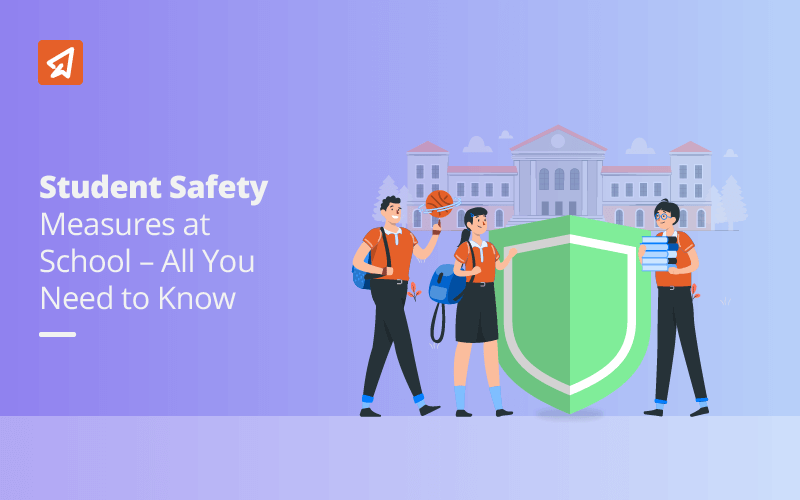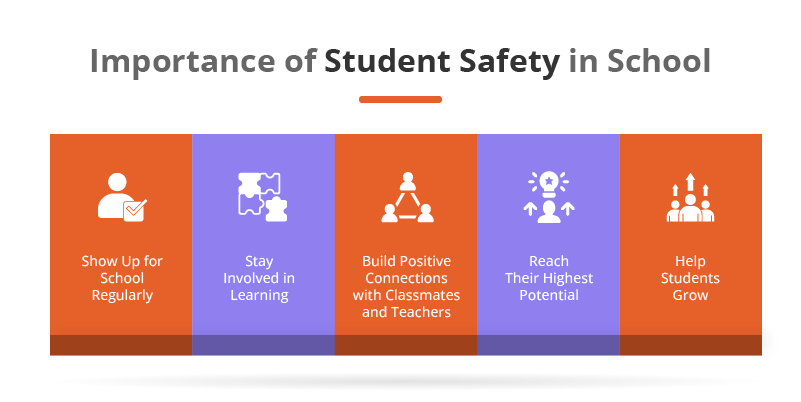Student Safety Measures at School – All You Need to Know

Ensuring the safety and well-being of students in Indian K-12 schools is a matter of paramount importance. With a growing awareness of the need for comprehensive student safety measures, educational institutions across the country are increasingly taking proactive steps to create secure learning environments. From implementing strict access controls and emergency response protocols to fostering a culture of vigilance and support, these safety measures are aimed at safeguarding students from potential threats and challenges.
In this article, we will delve into the various dimensions of student safety in Indian K-12 schools, exploring not only the physical security aspects but also the critical role of emotional and psychological well-being in nurturing safe and conducive learning spaces for our future generations.
Importance of Student Safety in School

Student safety matters for several reasons. When students feel safe, they’re more likely to:
- Show Up for School Regularly: The National Center for Education Statistics found that students who feel secure at school tend to attend regularly. In contrast, students who miss over 15 days a year are more prone to dropping out.
- Stay Involved in Learning: Feeling safe makes students more likely to stay engaged in their studies. When their minds aren’t preoccupied with worries about safety, they can focus on learning.
- Build Positive Connections with Classmates and Teachers: Feeling safe at school increases the likelihood of students forming positive relationships with their peers and teachers. Without feelings of anxiety or fear, they can connect more easily.
- Reach Their Highest Potential: Feeling safe allows students to focus on their learning, increasing the likelihood of reaching their full potential. When safety is assured, they can dedicate their energy to academic growth rather than concerns about their well-being.
- Help Students Grow: Making sure schools are safe is super important for helping students develop the social and emotional skills they need in life. When schools create a safe and supportive environment, it gives students the chance to learn things like understanding themselves, managing their feelings, being aware of others, getting along with people, and making smart decisions. These skills are key for handling life’s ups and downs, building good relationships, making wise choices, and being a positive part of society.
When students don’t feel secure, they might face various negative outcomes, such as:
- More stress and anxiety.
- Lower academic performance.
- Missing school.
- Dropping out.
- Mental health issues.
- Substance abuse.
- Getting involved in violence.
Apart from avoiding these downsides, student safety is crucial for the overall well-being of students. It boosts their resilience, helping them handle challenges better.
What Safety Measures Can Schools Take for Children’s Safety?
-
Ensure Campus Security
Relying on just one security guard at the front gate isn’t sufficient to safeguard the entire school grounds. Vulnerable spots like low walls or other entrances might provide an escape route for mischievous students or an easy entry point for trespassers. School safety guidelines need to cover the entire premises and take into account architectural features that are easy to maintain.
Installing measures like barbed wires or glass chips along the walls can enhance security. Guards should strictly regulate student departures from the compound, permitting it only after school hours or with recognised guardians. Additionally, they should be vigilant about allowing outsiders into the premises without prior permission.
-
Have a School Safety Team
It’s a good idea to set up a safety committee in the school to ensure the well-being of all students. The key members of the committee should include the Principal, representatives from the parent-teacher association, students and staff, and local ward members.
-
Visitor Management System
Implementing a visitor management system is important for enhancing school security. This involves creating a gate pass for every visitor, verifying their ID, and capturing a facial image. Entry should only be granted after the details are authenticated and confirmed by the admin department. Utilising visitor management software streamlines this process by automatically generating passes and sending notifications and approvals through the system.
-
Surveillance Camera
To ensure a safe environment, schools should invest in surveillance cameras. These cameras should cover the entire school premises, including the building and corridors. CCTVS must be well-maintained and continuously monitored by the safety team.
In case of any incidents such as fights, the use of dangerous items, or general indiscipline around the classrooms, immediate action should be taken. Authorities must vigilantly enforce school and classroom guidelines for both teachers and students.
-
Transportation and Commute Management
Leading schools prioritise the safety of their students by providing well-maintained transportation facilities, reducing the risk of unforeseen accidents. School authorities oversee buses and vans, ensuring they stick to a defined route exclusively for school children.
Adhering to fundamental school safety standards, regular maintenance of vehicles is mandatory. Drivers must hold valid licenses, and each vehicle should be equipped with internal surveillance cameras to monitor activities along the route.
-
Educate Students and Parents
Students must be familiar with school rules. Display these regulations in their school diaries or on classroom noticeboards. Make sure students understand the consequences of not following these rules.
Schools should also educate parents on safety measures to uphold their children’s well-being at home, especially during challenging times like the recent COVID-19 pandemic. For example, during the pandemic, it was essential for students to wear masks to school, and parents need to ensure their children have one with them to contribute to a safe environment for everyone.
-
Anti-Bullying Initiatives
Parents and school authorities might not always be aware, but instances of child abuse, bullying, and discrimination can happen on school grounds. Younger children often keep these incidents to themselves. The school must take steps to prevent the mistreatment of students.
Moreover, teachers should educate students about distinguishing between appropriate and inappropriate touches, empowering them to report any concerning actions. Anti-bullying committees play an important role in ensuring child safety by developing and implementing anti-bullying policies, investigating incidents, and providing support to victims. Encourage the children in your school to reach out to these committees for a safer environment.
-
Improved Infrastructure
When infrastructure and equipment aren’t safe, students face a higher risk of accidents. It’s crucial to establish classroom guidelines to teach the proper use of equipment and tools. Authorities should regularly inspect for broken or sharp furniture, damaged window panes, and inappropriate sports equipment provided to students.Safety measures should extend to checking the safety of laboratory equipment. Experiments involving heat and hazardous chemicals should be conducted under the guidance of teachers. Physics laboratories with heavy weights and electric circuits must adhere to safety limits. Attendants should consistently monitor lab standards and ensure proper storage.
-
Hygiene
Safety measures go beyond preventing physical injuries. A clean and sanitised environment is essential for focused studying. With growing awareness of social distancing and cleanliness, many schools are swiftly implementing hygiene policies in their safety guidelines.
Schools ensure a clean and hygienic environment through regular sanitation spraying campaigns, daily upkeep of grounds and classrooms, diligent restroom maintenance, and strategically placed dustbins. Promoting a clean area not only enhances the school’s image but also reduces absenteeism and illness among students.
-
Safety Training and Drills
An integral aspect of education is providing knowledge on maintaining safety within the school environment. Students should learn about appropriate conduct with their peers to prevent bullying and unnecessary conflicts. Since accidents like fires or electrical short circuits can happen unexpectedly, students should be equipped to handle emergencies.
Conducting practical mock drills in schools is crucial, as well as teaching students how to use fire extinguishers and exit strategies without panicking. Emergency helpline numbers should be visibly posted in different areas for quick reporting.
-
Preparedness for Emergencies
School buses should prominently display emergency contact numbers for the benefit of other travellers in case of mishaps. These contact numbers should include those for the local police station, ambulance service, PTA authority, school principal, etc. Additionally, for added safety, students can be issued identity cards containing emergency contact information for their parents or guardians.
-
First Aid and Safety Gear
Despite comprehensive safety measures, students may face unnoticed challenges, such as instances of mental abuse or potential dangers. Alongside implementing safety protocols, schools should establish a dedicated platform for addressing grievances. This way, students can promptly inform authorities if they notice anything concerning. First aid resources should also be readily available to attend to injuries before parents or ambulances arrive.
Closing Thoughts
By prioritising student safety and implementing these measures, schools can create an environment where students can learn, grow, and thrive. After all, a safe school is a place where students can focus on becoming the amazing individuals they’re meant to be. Take charge today – make sure that your students stay safe and learn well.
Frequently Asked Questions (FAQ)
1. What can parents do to help their children stay safe at school?
Parents can play an important role in ensuring their children’s safety at school by:
- Discussing school safety rules with their children.
- Encouraging their children to report any unsafe conditions or incidents to a teacher or staff member.
- Assisting their children in developing conflict resolution skills.
- Monitoring their children’s online activities.
- Staying informed about school safety policies and procedures.
2. How can schools promote a culture of safety?
Schools can nurture a culture of safety by:
- Clearly communicating safety rules and expectations to students, staff, and parents.
- Conducting regular safety training and drills.
- Establishing a supportive and respectful learning environment.
- Encouraging open communication about safety concerns.
- Implementing effective disciplinary measures for safety violations.
3. What should teachers do to create a safe school environment?
Teachers can contribute to a safe school environment by:
- Consistently enforcing safety rules.
- Closely supervising students.
- Teaching students about safety procedures.
- Cultivating a positive and supportive classroom environment.
- Being aware of their students’ needs.
4. What are some additional tips for kids to stay safe at school?
- Be aware of your surroundings and trust your instincts; report anything that feels wrong to an adult.
- Avoid talking to strangers or sharing personal information; inform an adult if you encounter someone unfamiliar.
- Refrain from sharing food or drinks to prevent illness.
- Do not bring dangerous items like knives, firecrackers, or weapons to school.
- Act as a bystander and assist others who may be experiencing bullying or harassment.
Last Updated on February 10, 2025
Reviewed by

Priya Kapoor | AVP - Academics
Priya Kapoor is an accomplished education professional with over 18 years of experience across diverse fields, including eLearning, digital and print publishing, instructional design, and content strategy. As the AVP – Academics at Extramarks, she leads academic teams in creating tailored educational solutions, ensuring alignment with varied curricula across national and international platforms...read more.










